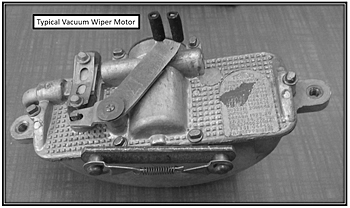Vacuum Wiper Motors
by Phil Lapin / CPPC Tech Committee
Vacuum wiper motors suck! If they do not, they aren’t working properly!
The vacuum wiper motor was invented in the 1920s, and was still used on the first Ford Bronco my family bought in the 1960s.
 Trico Corporation was involved in the early development of this device. Since they sold their products into the USA, Australia and Europe they came up with the name Tri Continental Company – Trico!
Trico Corporation was involved in the early development of this device. Since they sold their products into the USA, Australia and Europe they came up with the name Tri Continental Company – Trico!
Many people think that vacuum wipers aren’t worth having – due to their unique “personalities”. In reality they are quite reliable, powerful and compact. Their operation is undertaken through a vacuum line connected to the engine intake manifold. The deficiency with these units is that when the engine is under heavy acceleration, the vacuum drops in the intake manifold – and the wipers stop working. Many of you, including myself, remember letting off on the gas for a few seconds to let the wipers cycle while driving up hills!
I interviewed Melissa Klein recently, who owns “Cleansweep Wiper Motors by MK”. She is in Redmond, Oregon, and is the second generation owner of this business. Her uncle Keith (Kent) Jaquith started the original business, and was well known by car buffs. Melissa can be reached by calling 541 410 5671 or Emailing cleansweepwipers@gmail.com.
There are some 40-50 different vacuum wiper motor variations. Most all of these can be repaired, however repair parts for units from the 1920s and 1930s are becoming hard to locate. If the internal paddle area chamber is pitted – they can often still be sanded back to smooth. As of this writing, the older units can be repaired for around $100-125, while motors from the 1940s and 1950s typically run under $90. That is a serious bargain when the time and parts are added up! Melissa repairs many vacuum motors as a “sub-contractor” to other shops and companies (subtle hint: Go directly to Melissa!)
Various sources have stated that vacuum motors should be removed from the vehicle several times per year, and oil of some type put into the vacuum fitting. Great in theory, but in my 1940s vehicle the motor is in an extremely difficult location behind the dash. Depending on your vehicle, you may be able to suck oil into the motor by putting it into the actual vacuum hose. If the motor is not working at all, this may free it up, but this is not normally a long term solution.
If your wiper motor(s) do not work at all, first check that the vacuum hose is not leaking (Melissa has removed bees, ants and various other creatures from inside motors). As stated, getting an oil into the inner chamber may help out. The best solution is a preventative one: Turn the wipers on frequently to move the lubricant around internally! When rebuilding these motors, Melissa actually uses a light grease to cover all the internals, and frequent use helps to distribute this grease.
Yes, there are conversion kits to install electric wiper motors – but they are quite expensive and not as easy to install as one might imagine! So love your vacuum wipers and let them click/clack away!


